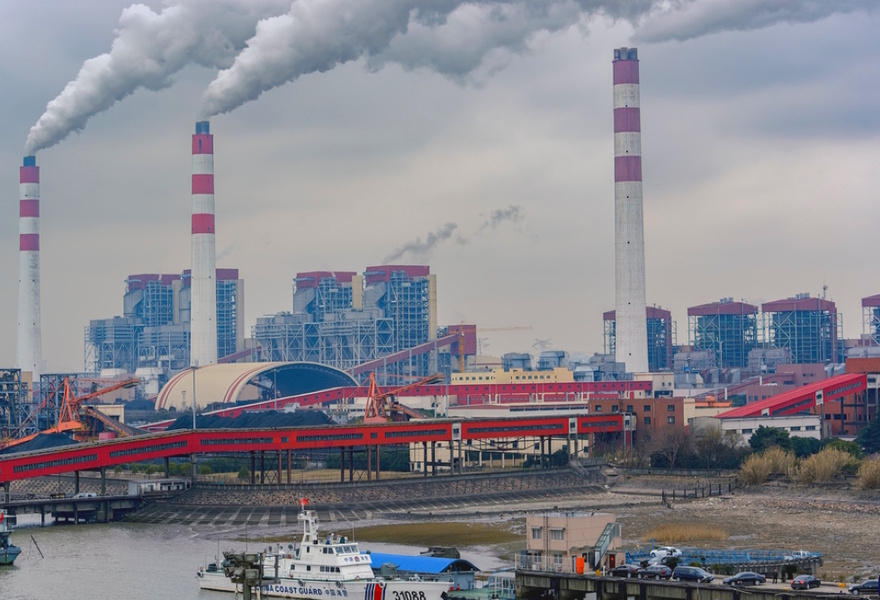Experts expect around 50 percent fewer new coal-fired power plants than announced
A high-quality survey provides a realistic picture of the investment dynamics. It should be the baseline for negotiations on phasing out this climate killer technology.

Coal-fired power plant in Shanghai: fewer new projects are cancelled in China than in other countries. | Photo: Shutterstock/Grochev
For the climate, it is a shocking number: by middle of last year, the capacity of new coal-fired power plants under construction or planned totalled 476 gigawatts worldwide. If all were built and ran until the end of their economic lifetime, this would make the international goal of limiting global heating to below 2 and preferably 1.5 degrees unattainable. However, a study now examines the official announcements, which are compiled by the US information service Global Energy Monitor, in terms of their implementation – and indicates that about 50 percent will be cancelled. The study was led by the Berlin-based climate research institute MCC (Mercator Research Institute on Global Commons and Climate Change), and published in the renowned journal Environmental Research Letters.
“For the negotiations on the global coal phase-out, it is important to have a realistic appreciation of the increase in power plants that still lies ahead,” explains Jan Steckel, head of the MCC working group Climate and Development and a co-author of the study. “Planning, and even construction of new plants may be put on hold if, for example, changes occur in finance, national energy strategies, or costs of renewable energies. We shed light on the baseline and thus the level of ambition of past and future coal agreements, the so-called JETPs.” Since 2021 “Just Energy Transition Partnerships”, representing countries in the Global South and wealthy industrialised countries have been negotiating on aid programmes for phasing out this particularly climate-damaging form of power generation. For South Africa, Indonesia and Vietnam, initial deals worth billions have already been struck.
The analysis now presented draws on a scientific survey of international experts. This is an established research method, frequently used, especially in the energy sector, for topics where hard statistics are not yet available. In a systematic search process, the research team identified 29 particularly knowledgeable experts from ten countries that account for 90 per cent of the new coal-fired power plants under construction or officially planned: Bangladesh, China, India, Indonesia, Laos, Mongolia, Pakistan, Turkey, Vietnam, and Zimbabwe. The experts were contacted in autumn 2021, i.e. before the conclusion of the first JETP agreements, to provide expertise for their own country and, to an extent, for other countries.
The responses show that the reduction in future coal investments negotiated with Vietnam and Indonesia corresponds more or less to what had been expected among experts anyway. The likely implementation of the announced coal-fired power plants varies greatly across countries: according to the forecast, the most cancellations are in Bangladesh and Mongolia, and the least in China. The research team also asked about the reasons for plan changes: in addition to technical and commercial aspects, the political economy of coal, i.e. consideration of regional jobs, tax payments or influence of the coal industry, also play an important role (MCC presented an extensive research work on this last year).
Overall, the experts assume that in the coming years and decades, around 215 gigawatts of new coal-fired power plant capacity will be installed in the ten countries examined. The study also looks at what this would mean for the climate. “In three quarters of the scientific climate policy scenarios with only 1.5 degrees of global heating, coal use worldwide is down to zero by 2050,” says Lorenzo Montrone, lead author of the study and until recently a PhD student at MCC. “Our study shows how important it is to have international support to phase out coal and develop alternatives. One way to deal with the newly built plants would be to limit their lifetime to 15 years. If that succeeded, the 1.5-degree limit would still be well within reach."
Reference of the cited article:
Montrone, L., Steckel, J., Nemet, G., 2023, Investment in new coal-fired power plants after the COVID-19 pandemic: Experts expect 170-270 GW of new coal, Environmental Research Letters
https://iopscience.iop.org/article/10.1088/1748-9326/accdf0/meta





